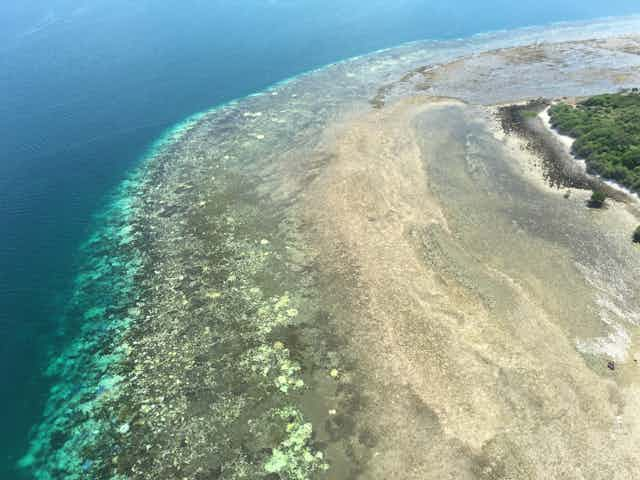The widespread bleaching event occurring across the Great Barrier Reef is unprecedented in scale and severity. It has rightly gained global media attention. Sadly, however, some of the headlines it has generated are factually incorrect or misleading:
Half of Great Barrier Reef “dead or dying” (ITV News)
Coral are bleaching along the entire Great Barrier Reef (Ars Technica)
Climate change has destroyed 93% of the Great Barrier Reef (RedOrbit)
The aerial surveys
Most of the recent international coverage was based on a press release from the ARC Centre for Coral Reef Studies at James Cook University. It explained how comprehensive aerial surveys were undertaken on “911 individual reefs … along the full 2,300 km length of the Great Barrier Reef. Of all the reefs we surveyed, only 7% (68 reefs) have escaped bleaching entirely”
The ARC survey assessed nearly one-third of all of the coral reefs on the Great Barrier Reef – a huge sample, analogous to polling 8 million Australians to find out their voting intentions. Underwater teams of scientific divers have confirmed the accuracy of these aerial surveys and are continuing to measure the ongoing impact of the bleaching.
The map below highlights the differences in bleaching patterns between the reef’s northern and southern sections.

It is important to recognise that if bleaching was observed on a reef, this does not mean a particular reef has entirely bleached. Indeed, 45% of the reefs assessed had 30% or less bleaching. In the southern section, only 1% of reefs were categorised as “severely bleached”.
Make no mistake: what is happening is very serious. But to state that “climate change has destroyed 93% of the Great Barrier Reef” is a misrepresentation of the situation.
Perhaps the more accurate way to frame the results (and indeed the wording used in the media release) is to say that only 7% of the coral reefs across the Great Barrier Reef have completely avoided bleaching. The situation is bad enough even when sticking to the facts.
There is clear evidence of the extent and severity of the bleaching, which supports the conclusion that the reef is experiencing the worst bleaching event ever seen. The northern half has been hit the hardest, with about 80% categorised as severely bleached.

The context
Part of the problem is that while many people around the world have heard of the Great Barrier Reef, few know enough about it to put such confronting headlines into context. For instance, it is important to understand the extent to which coral reefs form part of the much larger World Heritage Area.
Most of the articles accompanying the above headlines don’t clarify the following key points:
the World Heritage Area is the size of Italy or Malaysia, but only around 10% of this area is comprised of coral reefs.
more than 3,000 separate coral reefs collectively comprise the Great Barrier Reef, and these extend north into the Torres Strait, outside the boundaries of both the GBR Marine Park and the World Heritage Area.
the surveys show a mixed picture of very severe, moderate and little bleaching that changes dramatically from north to south along the 2,300 km length of the reef.
a bleached coral is not necessarily a dead coral, and the true extent of dead coral across the Great Barrier Reef will only become clear over the coming months.
while coral reefs are a key component of the ecosystem, they are not the only habitats suffering from the impacts of climate change.

Tourism in damage control
At the other end of the scale, some tourism operators and politicians have questioned the impacts of the bleaching, claiming that the effects are overstated.
This has given rise to a social media campaign involving pictures of healthy corals posted under the #GBRtoday hashtag, and has generated headlines such as:
Tourism industry pushes back against bleaching claims (Radio 4CA)
Tourism officials not panicking about coral bleaching on Far North Queensland reefs (Cairns Post)
An independent survey by tour operators using federal funding was co-ordinated by the Reef and Rainforest Research Centre (RRRC) in Cairns. This involved 402 surveys on reefs between Cairns and the northern Ribbon Reefs. It found 31% of their survey sites had not bleached, with the remaining 69% of the surveys showing varying levels of bleaching.
At 16 of the RRRC survey sites, 85% or more of the surveyed area was bleached to varying extents, ranging from moderate bleaching to coral death (bleaching levels 2-4, see page 8 of the report for more details).
At several of the Ribbon Reefs, between 30-40% of the corals at the surveyed site were dead. These results are not dissimilar to those of the ARC scientists.
The real picture
In summary, the level of bleaching of the coral reefs is catastrophic in the northern sector. Along the length of the Great Barrier Reef from north to south, there is a gradient of decreasing severity, from very severe to no sign of bleaching.
The magnitude of this bleaching, the worst ever to hit the reef, cannot be overstated. This is a massive blow to the UNESCO World Heritage site considered to be the most biodiverse on the planet.
Experts are predicting high levels of coral death across some parts of the Great Barrier Reef. Close to 50% mortality of bleached corals has already been measured north of Port Douglas. However, the wider impacts on the Great Barrier Reef ecosystem, and on the industries and communities that depend on a healthy reef, will not be fully apparent for months.

